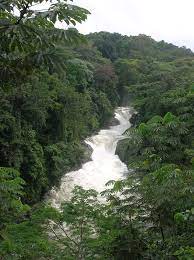This article has multiple issues. Please help improve it or discuss these issues on the talk page. (Learn how and when to remove these template messages)
|

Oba Hills Forest Reserve is a reserve in Iwo, Osun State, Nigeria, that covers about 52 square kilometres (20 sq mi) of hilly terrain with deep gorges. Oba Hills Forest Reserve is a small enclave encompassing three hills with a wide valley running in between. A large teak plantation is on its western side, covering about 12% of its total area.[1] Beyond the hills; only coppices are left on the over-exploited plantation. According to an IUCN report from 2003, about 12% of the reserve had been planted with teak.[2] Some chimpanzee sightings had been reported. In 1999, a dead chimpanzee was sold in a local market.[3] A 2009 report said that almost all the reserve had been converted to plantations and farms, with only two gullies remaining forest-covered. It is now believed that chimpanzees are nearly extinct in the reserve.[4]
It is located 253 metres above sea level.[5] Oba Hills Forest Reserve occupies 5,250 hectares of land. It has an abundance of significant plant and animal species. Five hills have significant ecological importance, which may help in the re-introduction and adaptation of important animal species.[6] The Oba Forest Reserve is home to a diverse range of flora and fauna, including various species of trees, plants, mammals, birds, reptiles, and insects. The forest ecosystem supports the survival and conservation of several endangered and endemic species. The reserve plays a crucial role in maintaining the ecological balance of the region. It helps regulate the local climate, control soil erosion, and preserve water resources by acting as a natural watershed. The forest also provides various ecosystem services, such as carbon sequestration and habitats for wildlife.[citation needed]

Oba Hill Forest Reserve is a small area made up of three hills connected by a broad valley. The northern hill features two gullies on its eastern side with a small area of surviving forest at its peak. The old-growth side of the northern hill may currently be inaccessible because it has been completely deforested. It is also flanked by a steep drop-off.
The middle hill has two peaks. The northern peak of the middle hill still has some forest near its summit and slopes. It features one forested area of about twenty-six hectares. It has a gully on its south-facing side with indications of logging and disturbance. The southern peak has been completely deforested.[7] On the reserve's western side which is beyond the hills, there is a sizeable teak plantation that makes up roughly 12% of its whole area. Re-generation of this area is impeded by repeated burns during the dry season. As a consequence of these escalating issues, and pressures due to a sharp population growth and economic collapse, protected forest reserve management areas are undergoing a rapid stage of evolution. Due to the demand for land and resources that result from the combined increased local population, human interaction, and aforementioned economic difficulty, local conservation efforts have been jeopardized.[8]
- ^ Kormos R, Boesch C, Bakarr MI, Butynaki TM (2003) West African Chimpanzees: Status survey and conservation action plan. Gland, Switzerland: IUCN.
- ^ Akintola, O. O., Abodunrin, E. K., Odeyale, O. C., Falana, A. R., Ogunbanjo, A. R., & Adeniran, T. (2022). Influence of Land Use Types on Physical and Chemical Properties in Oba Hill Forest Reserve, Iwo, South-western Nigeria. Journal of Applied Sciences and Environmental Management, 26(7), 1307-1377.
- ^ Rebecca Kormos, IUCN/SSC Primate Specialist Group (2003). West African chimpanzees: status survey and conservation action plan. IUCN. p. 127. ISBN 2-8317-0733-1.
- ^ Cite error: The named reference
Greengrass2009was invoked but never defined (see the help page). - ^ "Oba Hill Forest Reserve (Obahillforestreserve) Map, Weather and Photos - Nigeria: forest reserve - Lat:7.75 and Long:4.11667". www.getamap.net. Retrieved 2021-01-08.
- ^ "FG Approves Oba Hills Forest Reserve as National Park". 18 February 2022.
- ^ Collins WB (1960) Wildlife conservation in Ghana: part II. Ghana Fmr 5:28-35.
- ^ Uchida, K., & Ushimaru, A. (2014). Biodiversity declines due to abandonment and intensification of agricultural lands: patterns and mechanisms. Ecological Monographs, 84(4), 637-658.
© MMXXIII Rich X Search. We shall prevail. All rights reserved. Rich X Search
